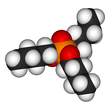Tributyl phosphate

| |||
| |||
| Names | |||
|---|---|---|---|
| Preferred IUPAC name
Tributyl phosphate | |||
| Identifiers | |||
3D model (JSmol)
|
|||
| ChEBI | |||
| ChemSpider | |||
| ECHA InfoCard | 100.004.365 | ||
| KEGG | |||
PubChem CID
|
|||
| UNII | |||
CompTox Dashboard (EPA)
|
|||
| |||
| |||
| Properties | |||
| C12H27O4P | |||
| Molar mass | 266.318 g·mol−1 | ||
| Appearance | Colorless to pale-yellow liquid[1] | ||
| Density | 0.9727 g/mL | ||
| Melting point | −80 °C (−112 °F; 193 K) | ||
| Boiling point | 289 °C (552 °F; 562 K) | ||
| 0.4 g/L[2] | |||
| Vapor pressure | 0.004 mmHg (25°C)[1] | ||
Refractive index (nD)
|
1.4231 (at 20 °C) [3] | ||
| Hazards | |||
| NFPA 704 (fire diamond) | |||
| Flash point | 146.1 °C (295.0 °F; 419.2 K) | ||
| Lethal dose or concentration (LD, LC): | |||
LD50 (median dose)
|
1189 mg/kg (mouse, oral) 3000 mg/kg (rat, oral)[4] | ||
LC50 (median concentration)
|
227 ppm (cat, 4–5 h) 123 ppm (rat, 6 h) 117 ppm (rat) 2529 ppm (rat, 1 h)[4] | ||
LCLo (lowest published)
|
2214 ppm (cat, 5 h)[4] | ||
| NIOSH (US health exposure limits): | |||
PEL (Permissible)
|
TWA 5 mg/m3[1] | ||
REL (Recommended)
|
TWA 0.2 ppm (2.5 mg/m3)[1] | ||
IDLH (Immediate danger)
|
30 ppm[1] | ||
| Safety data sheet (SDS) | External MSDS | ||
Except where otherwise noted, data are given for materials in their standard state (at 25 °C [77 °F], 100 kPa).
| |||
Tributyl phosphate, known commonly as TBP, is an organophosphorus compound with the chemical formula (CH3CH2CH2CH2O)3PO. This colourless, odorless liquid finds some applications as an extractant and a plasticizer. It is an ester of phosphoric acid with n-butanol.
Production
[edit]Tributyl phosphate is manufactured by reaction of phosphoryl chloride with n-butanol.[5]
- POCl3 + 3 C4H9OH → PO(OC4H9)3 + 3 HCl
Production is estimated at 3,000–5,000 tonnes worldwide.[6]
Use
[edit]TBP is a solvent and plasticizer for cellulose esters such as nitrocellulose and cellulose acetate, similarly to tricresyl phosphate. It is also used as a flame retardant for cellulose fabrics such as cotton.[7][8] It forms stable hydrophobic complexes with some metals; these complexes are soluble in organic solvents as well as supercritical CO2. The major uses of TBP in industry are as a component of aircraft hydraulic fluid, brake fluid, and as a solvent for extraction and purification of rare-earth metals from their ores.[6]
TBP finds its use as a solvent in inks, synthetic resins, gums, adhesives (namely for veneer plywood), and herbicide and fungicide concentrates.
As it has no odour, it is used as an anti-foaming agent in detergent solutions, and in various emulsions, paints, and adhesives. It is also found as a de-foamer in ethylene glycol-borax antifreeze solutions.[citation needed] In oil-based lubricants addition of TBP increases the oil film strength. It is used also in mercerizing liquids, where it improves their wetting properties. It can be used as a heat-exchange medium.[9] TBP is used in some consumer products such as herbicides and water-thinned paints and tinting bases.[10]
Nuclear chemistry
[edit]Tributyl phosphate is used in combination with di(2-ethylhexyl)phosphoric acid for the solvent extraction of uranium, as part of the purification of natural ores.[11] It is also used in nuclear reprocessing as part of the PUREX process. A 15–40% (usually about 30%) solution of tributyl phosphate in kerosene or dodecane is used in the liquid–liquid extraction (solvent extraction) of uranium, plutonium, and thorium from spent uranium nuclear fuel rods dissolved in nitric acid. Liquid extraxction can also be used for chemical uranium enrichment.[12]
Hazards
[edit]In contact with concentrated nitric acid the TBP-kerosene solution forms hazardous and explosive red oil.
References
[edit]- ^ a b c d e NIOSH Pocket Guide to Chemical Hazards. "#0625". National Institute for Occupational Safety and Health (NIOSH).
- ^ Velavendan, P; Sachithanantham, Ganesh; Pandey, N.K.; Geetha, R; Ahmed, M; Mudali, Kamachi; Natarajan, Rajamani (2012). "Studies on solubility of TBP in aqueous solutions of fuel reprocessing". Journal of Radioanalytical and Nuclear Chemistry. 295 (2): 1113–1117. doi:10.1007/s10967-012-1945-1. S2CID 95976379.
- ^ Pabst, Florian; Blochowicz, Thomas (December 2022). "On the intensity of light scattered by molecular liquids - Comparison of experiment and quantum chemical calculations". The Journal of Chemical Physics. 157 (24): 244501. Bibcode:2022JChPh.157x4501P. doi:10.1063/5.0133511. PMID 36586992.
- ^ a b c "Tributyl phosphate". Immediately Dangerous to Life or Health Concentrations (IDLH). National Institute for Occupational Safety and Health (NIOSH).
- ^ G. R. Dutton and C. R. Noller (1943). "n-Butyl phosphate". Organic Syntheses; Collected Volumes, vol. 2, p. 109.
- ^ a b "Tributyl Phosphate | SIDS Initial Assessment Profile" (PDF). Japan Chemical Industry Ecology-Toxicology & Information Center. Archived from the original (PDF) on 2007-10-11.
- ^ Alongi, Jenny; Malucelli, Giulio (2015). "Cotton flame retardancy: state of the art and future perspectives". RSC Advances. 5 (31): 24239–24263. Bibcode:2015RSCAd...524239A. doi:10.1039/C5RA01176K.
- ^ Gaan, Sabyasachi; Sun, Gang (June 2007). "Effect of phosphorus flame retardants on thermo-oxidative decomposition of cotton". Polymer Degradation and Stability. 92 (6): 968–974. doi:10.1016/j.polymdegradstab.2007.03.009.
- ^ "Tributyl Phosphate Product Information". Great Vista Chemicals. 20 January 2023.
- ^ "Tributyl Phosphate". Scorecard.
- ^ Kumar, Jyothi Rajesh; Kim, Joon-Soo; Lee, Jin-Young; Yoon, Ho-Sung (18 February 2011). "A Brief Review on Solvent Extraction of Uranium from Acidic Solutions". Separation & Purification Reviews. 40 (2): 77–125. doi:10.1080/15422119.2010.549760. S2CID 95358600.
- ^ Nuclear energy and nuclear weapon proliferation (1. ed.). Taylor.



